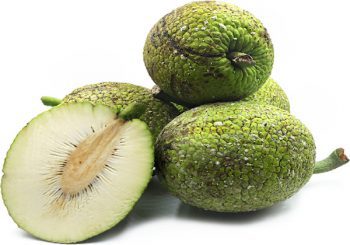Contributing writer for Wake Up World
Have you ever heard of breadfruit? It’s a rather strange name for a piece of fruit that sounds like it may smell or taste like bread. Instead, breadfruit is grown in tropical regions of the world and, like jackfruit, is a member of the mulberry family.1
Breadfruit trees were originally found in Polynesia. People use the fruit to bake, broil or fry the produce, similar to the way that potatoes are used. Others dry the flesh and grind it into flour to make bread and crusts. Polynesians brought the trees to Hawaii, when anthropologists believe it was colonized 1,000 years before Columbus landed in the Western world.
[pro_ad_display_adzone id=”110028″]
By the time European explorers came to the Western world in the late 1700s, the Polynesian settlers had established an agricultural system that supported hundreds of thousands of people.
More About Breadfruit
A breadfruit tree thrives in a Caribbean or tropical climate and can grow as tall as 85 feet, producing up to 200 fruits per year. The fruit is round, oval or oblong and can grow as big, or bigger than a basketball. The outer skin is neon green and covered in bumps, which hides the firm flesh people cook like potatoes or plantains.2,3
A single breadfruit yields enough fruit to feed a family of four. When the fruit is ripe, the interior is creamy white or yellow and soft. While it is a fruit, it’s treated and cooked more like a vegetable. The texture and taste resemble a potato, a grainy piece of bread or an artichoke heart, depending on the ripeness of the fruit and how it’s prepared.
Because the taste is bland, it lends itself to culinary creativity. As breadfruit ripens, it becomes sweeter, but it never approaches the sweetness of a papaya or mango. The British are credited with spreading it outside Polynesia.
Captain James Cook and botanist Sir Joseph Banks discovered breadfruit in Tahiti and believed it could be the answer to Britain’s food challenges of the era. The first time the trees were exported to the West Indies, the expedition was led by Lieutenant William Bligh from the infamous HMS Bounty.
Enroute to the West Indies from Tahiti, the lieutenant and members of the crew were cast into a small boat and all breadfruit tree plants were thrown overboard. After returning to England, Lieutenant Bligh was promoted to Captain and led another expedition to Tahiti in 1791, during which he successfully brought breadfruit plants to the Caribbean and Jamaica.
Although the plants thrived, the people didn’t enjoy the food and ate it only when they had to. Currently, breadfruit trees are grown in more tropical areas in Africa, Australia, southeast Asia and South America. Trees can also be found in the U.S. in Hawaii and South Florida.
The fruit, which is packed with nutrients, is a staple in Hawaii. The flesh of breadfruit is high in antioxidants, calcium, carotenoids and fiber. It also contains copper, niacin, magnesium, phosphorus and protein. Interestingly, although it’s a fruit, one cup provides 5% of the RDA for protein, 14% of magnesium and 31% of potassium.4,5
Could Breadfruit Be the Next Superfood?
Although it has been a traditional staple for centuries, there has been a distinct lack of scientific evidence demonstrating the health impacts of breadfruit. In a recent study from the University of British Columbia, scientists analyzed flour made from breadfruit.6,7 The objectives were to identify any health problems associated with breadfruit flour in consideration of it as a sustainable source of nutrition and to establish it as a functional food.
In the lab, using an enzyme digestion model, they found the protein in breadfruit was easier to digest than protein found in wheat. The digested flour was tested for cytotoxicity by applying it to caco-2 cells. These cell lines are used to analyze drug permeability and they have been used for the past two decades “as a model of the intestinal barrier,” according to researchers from Italy.8,9
The researchers found no difference between wheat and breadfruit in terms of cytokines and immune factors. When breadfruit-based food was substituted for wheat in a diet for mice, they found there was no sign of illness, death or malnutrition related to the change. Major bacteria and histology of the ileum were similar between the mice fed with breadfruit and those fed with wheat products.
The researchers concluded: “No negative health outcomes were observed in studies with in vitro or in vivo models and breadfruit flour is a healthy alternative to other starches for modern foods.”10
The combination of scientific evidence and knowledge that the breadfruit tree is high-producing and easily grown may provide health benefits and address food shortages around the world. Susan Murch, Ph.D., is a chemistry professor and one of the researchers on the study. She said:11
“Breadfruit is a traditional staple crop from the Pacific islands with the potential to improve worldwide food security and mitigate diabetes. While people have survived on it for thousands of years there was a lack of basic scientific knowledge of the health impacts of a breadfruit-based diet in both humans and animals.”
Doctoral student Ying Liu shared:12
“Overall, these studies support the use of breadfruit as part of a healthy, nutritionally balanced diet. Flour produced from breadfruit is a gluten-free, low glycemic index, nutrient-dense and complete protein option for modern foods.”
The Impact Grains Have on Health
The potential exists to substitute wheat flour for breadfruit flour in baked breads and crusts. While breadfruit flour is gluten-free, wheat products are not. In years past, only people with wheat allergies and celiac disease sought out gluten-free products. After adopting a diet free of gluten products, they often reported a resurgence of good health.13
Gluten is a protein found in wheat and cereal grains.14 When these proteins are in contact with water, they form an elastic bond that gives bread the ability to hold its shape. Gluten can also be found in barley, oats, rye and spelt and may hide in processed foods under a variety of names, including malts or natural flavoring.15
Some people react negatively to just a small amount of gluten because their body identifies it as a toxin. When left unchecked, excessive gluten consumption can predispose a person to nutrient deficiencies along with neurological and psychological conditions. It can have a potentially negative effect on the joints, liver, nervous system and skin.16
In addition, professionals at the Celiac Disease Foundation believe that undiagnosed celiac disease may contribute to the development of “autoimmune disorders like Type 1 diabetes and multiple sclerosis (MS), dermatitis herpetiformis (an itchy skin rash), anemia, osteoporosis, infertility and miscarriage … epilepsy and migraines, short stature and intestinal cancers.”17
As you might imagine, a gluten intolerance can trigger signs of gastrointestinal distress, including bloating, diarrhea and belly pain. Beyond this, you might also experience anxiety, confusion, headache, nausea or joint and muscle pain. Although gluten-free food options may look like they help people who have a wheat allergy or celiac disease, it’s prudent to approach these cautiously.
I believe most processed, packaged gluten-free foods are glorified junk foods because they are some of the most ultraprocessed foods in the store. They lack fiber, are often loaded with toxic amounts of sugar and salt and include unhealthy fats in their list of ingredients.18
Whether you have a sensitivity to gluten or not, nearly everyone can benefit from eating fewer grains, which are high in net carbs. The potential for using breadfruit flour and baked goods may help reduce your exposure to gluten and the glycemic index of the foods you eat.
Your Body Needs Fiber
Breadfruit is high in fiber, which is far more important than science had thought before. In fact, just 1 cup contains 43% of all the fiber you need for the day.19 A low fiber diet can alter your gut flora. In one study using an animal model, a low fiber diet altered the gut flora, which was also passed on to the offspring.20
In some cases, even after the mice were fed high-fiber meals, the gut was unable to repopulate with certain bacteria that had been severely diminished. Past studies have confirmed that the human microbiome has changed over the course of history, as has the human diet.21 In general, researchers have found that people who eat more plant-based foods have a more diverse gut microbiome.
The benefits of eating enough fiber include preventing leaky gut syndrome that also triggers anxiety, joint pain, fatigue and bloating.22 Food Integrity Now explains leaky gut syndrome this way:23
“The wall of the intestine is considered semi-permeable. This means it only allows certain things to enter the bloodstream and blocks other things from entering the bloodstream. For instance, specific molecules and nutrients are allowed to pass through but toxins and large undigested food particles are blocked.
When you have leaky gut, the pores in your small intestine widen and this allows undigested food particles and toxins, that would normally be blocked, to enter your bloodstream. These particles and toxins aren’t recognized and the immune system goes into attack mode because they are not supposed to be in the blood. In essence, the immune system literally recognizes these undigested particles as dangerous.”
Fiber has other health benefits as well. For example, researchers have found an inverse relationship between fiber and heart attack, showing those eating a high fiber diet have a 40% lower risk of heart disease.24
As I’ve written before, fiber can delay brain inflammation and aging that negatively influence your function. In particular, low fiber diets can be harmful to older adults, as they have a lower ability to produce butyrate, a nutrient that helps delay brain aging.
Sustainable Crop May Impact Global Health
Breadfruit is a sustainable, high production crop that has a low glycemic index and may provide one answer to the growing problem of food shortages around the world. It’s also easy to grow in the right climate. With winter fast approaching in the Northern Hemisphere, it might be time to think about dramatically reducing your food bill by growing an indoor organic garden.
As the cost of organic produce rises due to demand and problems related to the pandemic, many have taken to starting their own backyard gardens and container gardens. If you thought fall was the time to hang up your gardening gloves, you may want to reconsider since you can harvest spinach, beets and carrots well into February. Many herbs and vegetables can be grown indoors with adequate lighting.
You’ll enjoy the benefits of winter gardening, which include savings on your grocery bill and the assurance that the produce you’re harvesting is from organically grown, non-GMO seed. Before diving in, take time to plan your garden.
Some plants do well with an extended growing season, while others are planted in the fall to overwinter for an early spring harvest. Still others do best in container gardens indoors. Gardening is good for your health in other ways, as it’s a simple way to reduce stress and get a little exercise, something each of us needs.
References:
- 1 Palomar College
- 2 Taste
- 3 Gardening Know How, September 5, 2019
- 4 Valley Isle
- 5, 19 Nutrition Data
- 6, 10 PLOS|One, 2020, doi.org/10.1371/journal.pone.0236300
- 7 Study Finds, September 20, 2020
- 8 Cell Biology and Toxicology, 5;21(1)
- 9 Science Direct
- 11, 12 University of British Columbia Okanagan, September 17, 2020
- 13 American College of Allergy, Asthma and Immunology
- 14 Celiac Disease Foundation
- 15 The Celiac Scene, December 3, 2015
- 16 Mayo Clinic March 6, 2018
- 17 Celiac Disease Foundation, Celiac Disease Foundation
- 18 Current Developments in Nutrition, 2020;4(2):751
- 20 Nature January 14, 2016;529:212
- 21 National Geographic March 26, 2015
- 22, 23 Food Integrity Now, May 27, 2015
- 24 JAMA, 1996;275(6):447
Originally published at mercola.com and reproduced here with permission.
Recommended articles by Dr. Joseph Mercola:
- High Blood Pressure Linked to Increased Risk of Dementia
- Cholesterol Does Not Cause Heart Disease
- CBD Has Unique Ability to Cross Blood-Brain Barrier
- Water and Homeopathy: Latest Discoveries at Science’s Cutting Edge
- Sugar Substitutes: What’s Safe and What’s Not
- Unveiling the Depths of the Human Psyche: Psychedelics May Unlock Parts of the Mind That Are Normally Inaccessible
- What Should Your Poop Look Like?
- The Endocannabinoid System and the Important Role it Plays in Human Health
- Magic Mushrooms May Hold Key to Long-Term Relief from Anxiety and Depression
- Scientific Links Between Processed Foods and Depression
About the author:
Born and raised in the inner city of Chicago, IL, Dr. Joseph Mercola is an osteopathic physician trained in both traditional and natural medicine. Board-certified in family medicine, Dr. Mercola served as the chairman of the family medicine department at St. Alexius Medical Center for five years, and in 2012 was granted fellowship status by the American College of Nutrition (ACN).
While in practice in the late 80s, Dr. Mercola realized the drugs he was prescribing to chronically ill patients were not working. By the early 90s, he began exploring the world of natural medicine, and soon changed the way he practiced medicine.
In 1997 Dr. Mercola founded Mercola.com, which is now routinely among the top 10 health sites on the internet. His passion is to transform the traditional medical paradigm in the United States. “The existing medical establishment is responsible for killing and permanently injuring millions of Americans… You want practical health solutions without the hype, and that’s what I offer.”
Visit Mercola.com for more information, or read Dr. Mercola’s full bio and resumé here.
[pro_ad_display_adzone id=”110027″]








